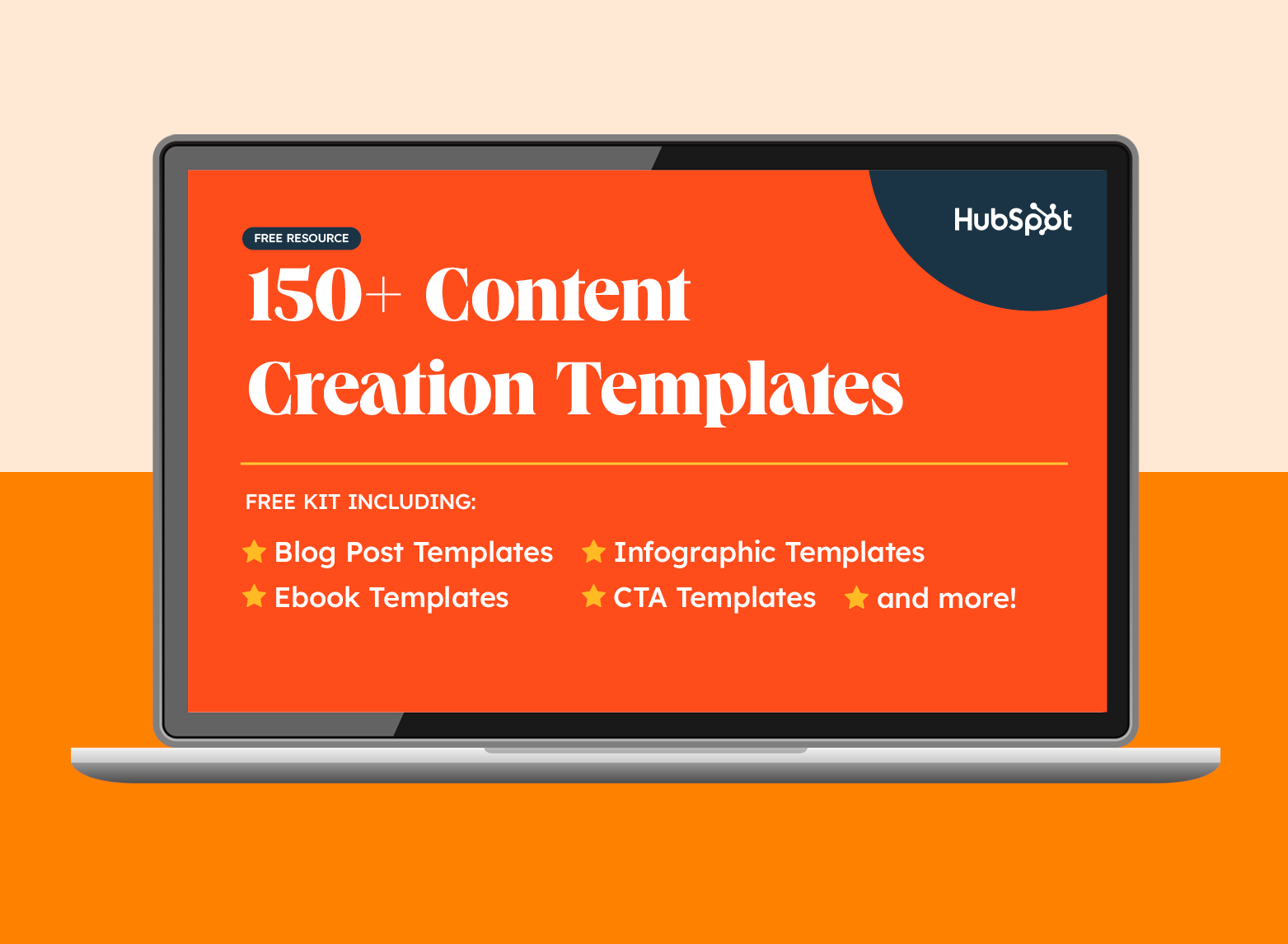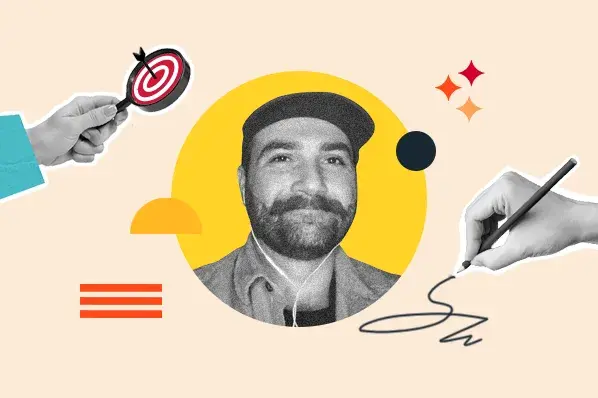I started my marketing career as a junior community marketer. I should have been pretty prepared for the job. I’d spent £50,000 on my marketing degree and four years studying.
Yet, just a few hours into my first day, I realized I wasn’t well-prepared. I was woefully inept.
Right after lunch, my manager asked me to create one-pagers, blogs, email subject lines, and case studies. “This,” he described, “is marketing bread and butter.” And yet, I had no idea where to start.
My degree claimed I could ‘do marketing,’ but I had no clue how to write persuasively, convince customers, or use words to catch the eye.
Yet, all of these new tasks involved persuasive copywriting, something I knew nothing about.
Fortunately, I quickly discovered behavioral science. I learned how psychology could reveal the secret to persuasive copywriting. Later, I interviewed experts like Richard Shotton, Rory Sutherland, and Jonah Berger, quizzing them on how they write better copy.
Over a decade, I’ve discovered dozens of copywriting tips that work. A treasure trove of tactics that I wish I’d known all those years ago. So, just in case you’re in the same position as me, here are the eight copywriting tips I wish I’d known when I started in marketing.
Copywriting Insights I Wish I Had From Day One
1. Write Concrete Copy
In his book (2023), Richard Shotton shared arguably the most important copywriting study.
In 2021, Richard and his colleagues Mike Treharne and Leo Burnett showed participants vague phrases and concrete phrases and asked them to remember both.
Concrete phrases, like “fast car,” were recalled with 6.7% accuracy, while abstract phrases like “innovative quality” were forgotten, with only 0.7% recalled.

There’s a concrete takeaway here. Don’t use vague or abstract terms in your copywriting. Instead, use concrete phrases that readers can visualize.
This copywriting tactic will not only help with memorability but also boost sales. A 2022 study (cited in Magic Words) suggested that changing an Oreo product description from “150 grams per pack” to “15 cookies per pack” increased sales.
The concrete descriptions made Oreo’s benefits more salient and made customers more likely to buy.

2. Anchor Your Claims
Huel, the rapidly growing protein shake company, knows how to use concrete phrases in their ads.

Rather than using technical descriptions (left of the image), they use easy-to-visualize examples like eggs, oranges, salmon filets, and bananas (right of the image).
But can you spot the other tactic they use?
Each of their concrete examples acts as an anchor. Readers know salmon filets contain plenty of omega-3, so the anchor makes Huel’s drink seem even more nutritious.
One study on San Francisco residents (cited in Blindsight) found that the average political donator sent $64 to their candidate over the election campaign.
But simply telling a donor “someone else offered $400” increases the average to $143. Like Huel’s “salmon filet, " this anchor changed the donor’s perception and behavior.
Read more:
3. Don’t Hide Effort
In 2003, researchers Chinander and Schweitzer showed students two different presentations: one on electronic ink and the other on optical switches (both were as dull as they sound).
Half the students were told that the presentation on electronic ink took eight hours to prepare, while the optical switch presentation took just 30 minutes. The other half were told the opposite: that the optical switch presentation took eight hours to prepare, while the electronic ink pitch was whipped together in 30 minutes.
In both scenarios, the presentation was the same.
Hearing that a presentation took longer to prepare made the presentation more engaging. Simply learning that effort went into it made students rate it higher.
This finding can easily be applied to your copywriting. Simply highlight the work you’ve put in, like I did with this Reddit ad. Tweaking my copy to say, “I’ve spent 480 minutes listening to marketing experts … Here are the six best marketing lessons I’ve heard,” boosted my click-through rate by 45%.
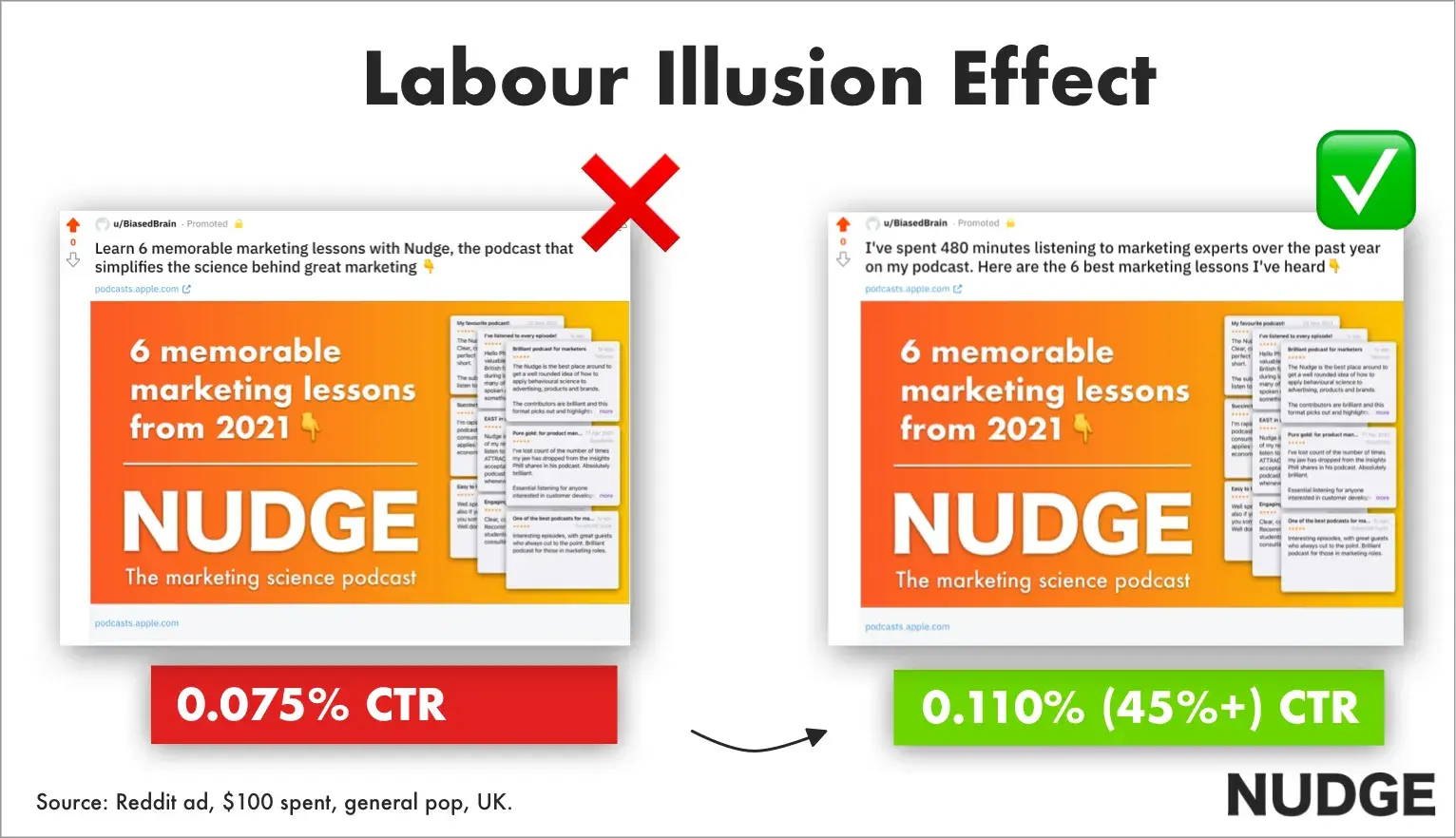
4. Be Very Specific
Take a closer look at that last ad. You’ll notice I said “480 minutes,” not eight hours or one working day. I was very specific on purpose.
A 2006 study compared ads with non-specific numbers versus ads with specific numbers.
The researchers Schindler and Yalch found that ads for a law firm performed better when stating it served customers for “10 years” rather than “a decade.”
Ads suggesting that a fictitious deodorant lasted precisely 47% or 53% longer were deemed more accurate by 199 participants, compared to a non-specific “50% longer” claim.
Perhaps that’s why Heinz reminds customers of its 57 varieties, while KFC raves about its 11 secret herbs and spices.

5. Present Tense Persuades
In 2023, best-selling author Jonah Berger ran a study analyzing 500,000 product reviews.
Jonah and his team compared reviews written in the present tense (“the soup is delicious”) with reviews written in the past tense (“the soup was delicious”).
They discovered that reviews written in the present tense received 26% more helpful upvotes, making readers 12% more likely to buy.
It’s a vital finding that many forget. This Tesla post (reposted by Elon Musk) would have been more persuasive if it mentioned how the company was growing, rather than how it grew.
![[alt] Copywriting insights example: Tesla](https://53.fs1.hubspotusercontent-na1.net/hubfs/53/copywriting-insights-7-20240730-3897043.webp)
6. Almost Always Alliterate
Participants in one 2022 study (cited in The Illusion of Choice) were shown one of two proverbs. Half were alliterating proverbs, the others were non-alliterating proverbs with the same meaning.
Some participants read that “a break will help you flourish.” Others read that “a break will help you blossom.” Some read how “barking dogs seldom wound,” while others read that “barking dogs seldom bite.”
Later, the participants were asked to recall the proverbs. The alliterating versions were 22% more memorable.
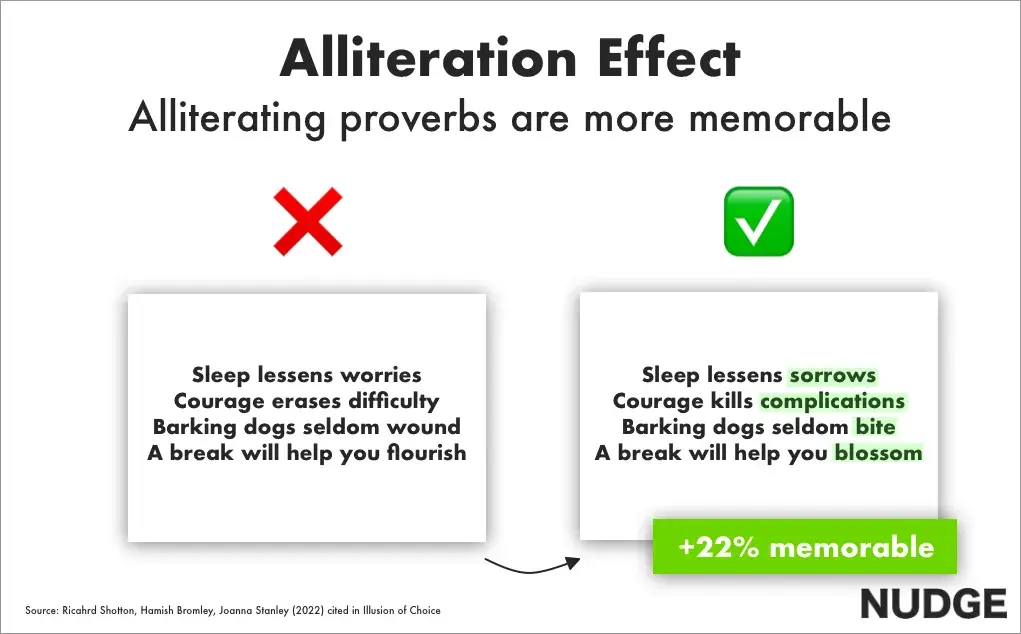
Maybe that’s why so many companies opt for alliterating slogans. Nestle claims “Good food, good life.” KitKat says, “Have a break, have a KitKat.” While Jaguar tells customers “Don’t dream it. Drive it.”
But this tip isn’t just for swanky slogans. Expert copywriter Harry Dry shares how to apply this tip on a typical website call to action.
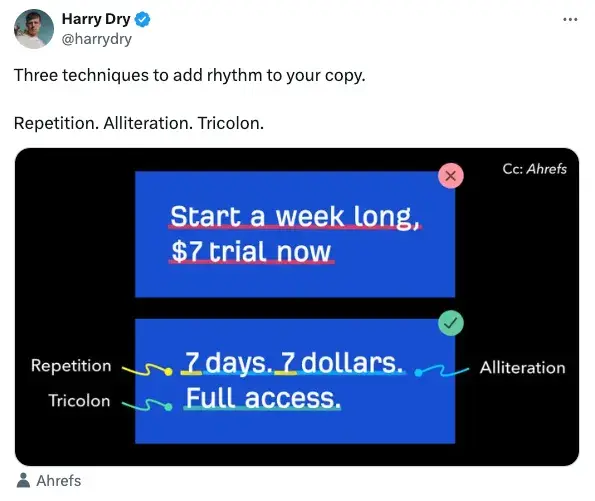
Read more:
7. Don’t Fear Negations
Negative words like nobody, none, no, nothing, and nowhere attract attention.
Two researchers in 2022 analyzed 15,608 posts on Facebook and X and found that posts with negation words gained more engagement.
A tweet promoting a newsletter was 17.8% more effective if a negation was used, while a negation-packed Facebook post received 17.6% more engagement.
Perhaps that’s why this famous IBM line has stuck around for decades.

8. Second Person Pronouns
In 2022, a group of three researchers studied thousands of brand posts on Facebook, comparing their engagement and impressions.
They discovered that posts containing second-person pronouns (you, your, you’ll) increased the performance of the posts.
It wasn’t just Facebook posts. Blog titles that include “you” and “you’ll” made readers feel more engaged and made the brand behind the post appear more favorably in the reader's eye.
Next time you write a post, consider adding a “you.”
These 8 tips are what you need to craft compelling copy. Now don’t forget it took me 10 years to find these tips but just 8 ½ minutes for you to read this post. So bookmark this blog, you might want to save it for a rainy day.
This blog is part of Phill Agnew’s Marketing Cheat Sheet series where he reveals scientifically proven tips to help you improve your marketing. To learn more, listen to his podcast, Nudge, which is a proud member of the HubSpot Podcast Network.
Copywriting
-Jun-03-2024-08-22-09-8305-PM.png?width=112&height=112&name=Untitled%20design%20(25)-Jun-03-2024-08-22-09-8305-PM.png)

